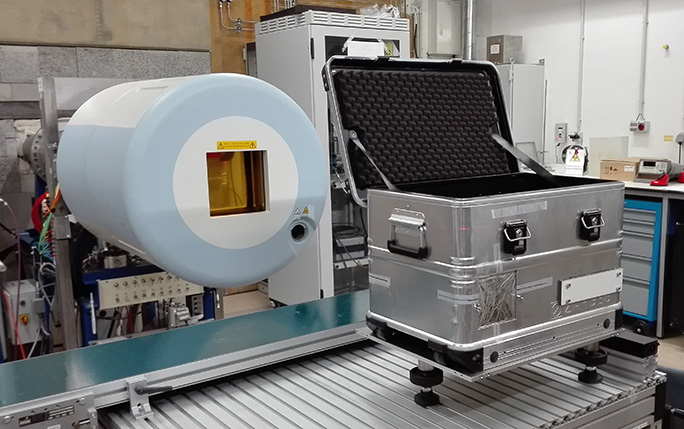Detector developments at UCL

A detailed description of the detector development at University College London by OMA Fellow Laurent Kelleter has recently been published in Physics in Medicine & Biology.
The commissioning and operation of a particle therapy centre requires an extensive set of detectors for measuring various parameters of the treatment beam. Among the key devices are detectors for beam range quality assurance (QA). Range QA measurements with standard scanning water phantoms is very time-consuming, while faster detectors are expensive and do not use water-equivalent material.
At UCL, a novel range telescope based on water-equivalent plastic scintillator and read out by a large-scale CMOS sensor was developed for fast range QA measurements. The detector is made of a stack of 49 plastic scintillator sheets with a thickness of 2-3 mm and an active area of 100 by 100 mm2, resulting in a total physical stack thickness of 124.2 mm. This compact design avoids optical artefacts that are common in other scintillation detectors.
The range of a proton beam is reconstructed using a novel Bragg curve model that incorporates scintillator quenching effects. Measurements to characterise the performance of the prototype were carried out at the Heidelberger Ionenstrahl-Therapiezentrum (HIT, Heidelberg, Germany) and the Clatterbridge Cancer Centre (CCC, Bebington, UK).
The maximum difference between the measured range and the reference range was found to be 0.41 mm at a proton beam range of 310 mm and was dominated by detector alignment uncertainties.
With the new detector prototype, the water-equivalent thickness of PMMA degrader blocks has been reconstructed within 0.1 mm. An evaluation of the radiation hardness proved that the range reconstruction algorithm is robust following the deposition of 6,300 Gy peak dose into the detector. Furthermore, small variations in the beam spot size and transverse beam position are shown to have a negligible effect on the range reconstruction accuracy. The potential for range measurements of ion beams was also investigated.
More information:
Laurent Kelleter, Raffaella Radogna, Lennart Volz, Derek Attree, Anastasia Basharina-Freshville, Joao Seco, Ruben Saakyan and Simon Jolly. ''A scintillator-based range telescope for particle therapy.'' Physics in Medicine & Biology (2020).